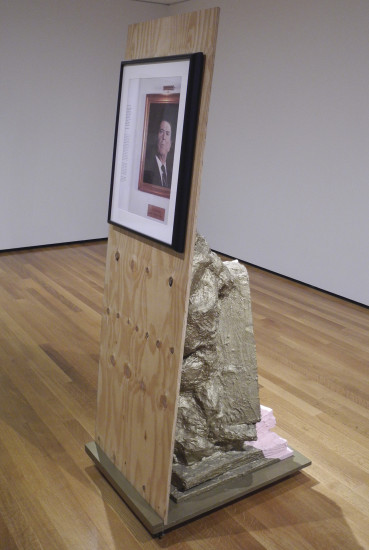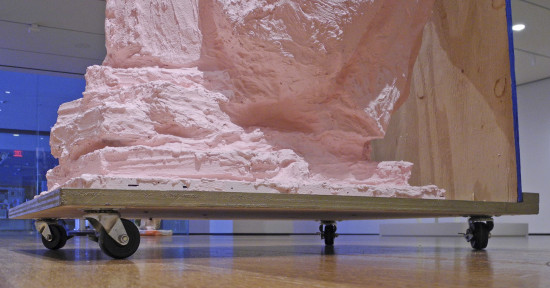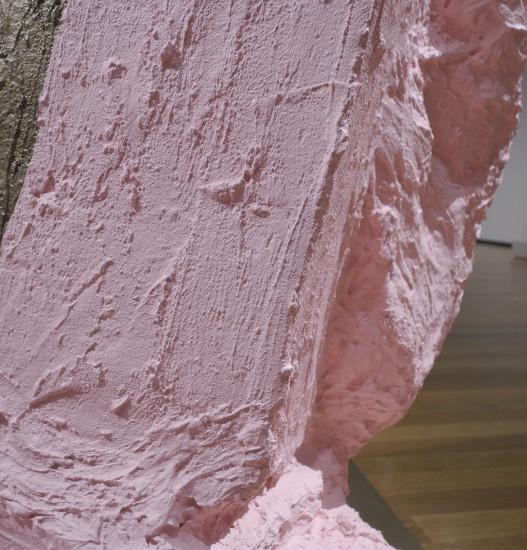Returning blogger Samantha Owens is a second-year graduate fellow in the Winterthur/University of Delaware Program in Art Conservation interested in modern and contemporary objects. She spent the summer in the Objects Conservation lab at the Cleveland Museum of Art, focused on contemporary art.

Hans Haacke with Sculpture, 2005. Rachel Harrison (American, b. 1966). Wood, chicken wire, polystyrene, cement, acrylic, wheels, and pigmented inkjet print of Oelgemaelde, Hommage à Marcel Broodthaers (1982) by Hans Haacke (German, act. U.S., b. 1936). 190.5 x 61 x 78.7 cm. Courtesy of the artist and Greene Naftali, New York.
It was a busy day of installation for the upcoming show at the Cleveland Museum of Art, Gloria: Robert Rauschenberg & Rachel Harrison. Rachel Harrison was at the museum, working with Assistant Curator of Contemporary Art Beau Rutland to determine the placement of her sculptures. Later, Harrison spoke with my supervisor, Associate Conservator of Objects Samantha Springer (soon to be Conservator at the Portland Art Museum) and myself. We had several questions about one of her sculptures as we thought about how to care for and maintain it in the future.
The work in question was Hans Haacke with Sculpture, created in 2005. The work consists of an amorphous form that sits on a wood base with four wheels, and a plywood plank that leans onto the form with a framed image attached. The image is a scan of a book about Hans Haacke, another contemporary artist. The page scanned contains an image of Ronald Reagan, which Haacke painted in 1982 as part of his work, Ölgemälde, Hommage a Marcel Broodthaers (Painting in Oil, Homage to Marcel Broodthaers). So, as Harrison explained during our interview, we have an artist looking at an artist who’s looking at an artist. The interview continued with an explanation of Harrison’s working method and materials.
When I arrived at the CMA for the summer, this interview was already on my mind. I had been behind-the-scenes (read: manning the camera) for two artist interviews during a previous internship at the Hirshhorn Museum and Sculpture Garden, but I had not participated in the formation of interview questions. Gaining more experience with the artist interview process was one of my summer goals, and I prepared by watching clips of artist interviews, reviewing notes, and most helpfully, I participated in VoCA’s Artist Interview Workshop for graduate students at this year’s ANAGPIC meeting. This workshop helped me to think about what questions to ask and how to phrase them, avoiding bias and inviting open conversation.
Harrison’s art uses a great range of materials, and Hans Haacke with Sculpture was a prime example. The materials in this one work included wood, chicken wire, polystyrene, cement, acrylic paint, and an ink-jet print. It even had wheels! As with many modern materials, it is unclear how certain parts will age. Thus, staging an interview now is incredibly helpful to understand future treatment options and limitations. For example, the wheels on this piece are functional, but they do not move during display. Is it important that the wheels always remain functional, or only that they appear so? Questions like this can get very specific or theoretical, but it is exceedingly useful to have that information for the future, when we cannot predict how a material will age. It is reasonable to suspect that plastic wheels, which bear constant weight, will degrade over time. After talking with Harrison, we understood her intent for the work and had answers to many of our questions. The wheels, for example, need to appear functional and unbroken, but as the sculpture is not intended to move while displayed, their actual functionality is unimportant.
SS: The fact that [the casters] function, is that important in terms of the meaning of the work or to you?
RH: Not anymore. It’s important to how the work was made because especially this time I was making a lot of things and I was working alone in the studio and it was the easiest way to move them around. . . . So I made a number of pieces on wheels. Now I don’t care because I don’t need to move them anymore. I would say as long as it looked the same. In this situation, I wouldn’t want them to be different wheels.
Another change inherent to the materials used is that the wood will oxidize and darken. Harrison acknowledged that since she acquired the plywood, the color has changed and that is expected. We also discussed the ink-jet print and the degree of fading that would be acceptable in the future, and at what point of fading it would be unexhibitable. Obtaining documentation of the type of paper used, and a copy of the digital file she printed from will ensure that a conservator in the future has all the options for treatment, whether that be reproduction or not.
During the interview, we took notes and recorded the audio. This will be kept as a record for the future: we conservators know the importance of thorough documentation. We now have a plan moving forward as we work to preserve this sculpture. We understand when chips to the paint surface are acceptable for the interpretation of the work, and when they cloud the intent and require treatment. We understand the structure of the painted form and have information on the exact materials used. Harrison even pointed out some of the underlying materials in her painted form, like a rag and chicken wire visible through the cement coating.
After the interview, I thought about the questions asked and the responses Harrison gave. We had sent the questions to Harrison in advance, and the answers she provided during her visit to the CMA clearly addressed our points and a wealth of additional information was provided. I had originally written a question asking how she wanted visitors to interact with the work, which I thought was answered after I saw the work installed: no platform or stanchions and accessible on all sides, at least four feet from the wall. But after our interview had ended, she mentioned being interested in answering that particular question, indicating her thoughtfulness regarding the work. It was fascinating to hear more about her process and intent, as well as learning her feelings about the sculpture’s aging. We now have very helpful information that will inform conservation treatments that may be required down the road. This proactive approach helps ensure the best preservation of the artwork.
I would like to thank Rachel Harrison for her generous time, and Samantha Springer for her help with this project.


